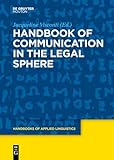Handbook of Communication in the Legal Sphere / ed. by Jacqueline Visconti.
Material type: TextSeries: Handbooks of Applied Linguistics [HAL] : Communication Competence. Language and Communication Problems. Practical Solutions ; 14Publisher: Berlin ; Boston : De Gruyter Mouton, [2018]Copyright date: ©2018Description: 1 online resource (X, 488 p.)Content type:
TextSeries: Handbooks of Applied Linguistics [HAL] : Communication Competence. Language and Communication Problems. Practical Solutions ; 14Publisher: Berlin ; Boston : De Gruyter Mouton, [2018]Copyright date: ©2018Description: 1 online resource (X, 488 p.)Content type: - 9781614516699
- 9781501501104
- 9781614514664
- 340/.14 23
- K213
- K213 .H359 2018
- online - DeGruyter
- Issued also in print.
| Item type | Current library | Call number | URL | Status | Notes | Barcode | |
|---|---|---|---|---|---|---|---|
 eBook
eBook
|
Biblioteca "Angelicum" Pont. Univ. S.Tommaso d'Aquino Nuvola online | online - DeGruyter (Browse shelf(Opens below)) | Online access | Not for loan (Accesso limitato) | Accesso per gli utenti autorizzati / Access for authorized users | (dgr)9781614514664 |
Frontmatter -- Preface -- Contents -- List Of Figures -- List Of Figures -- Part I: The Foundations Of Legal Language -- 1. Legal Drafting -- 2. The Interpretation Of Laws -- 3. Language Rights -- 4. Language Planning And Legal Systems -- 5. Semantic Processing Of Legal Texts -- Part II: Forensic Linguistics And Court Setting -- 6. Implicit legal norms -- 7. Authorship attribution analysis -- 8. Topic management in police-suspect interviewing -- 9. Forensic voice comparison -- 10. Narrative practices and voice in court -- Part III: Legal language outside of court -- 11. Linguistic analysis in trade mark law: current approaches and new challenges -- 12. Defamation, language and linguistics -- 13. Future directions in law and popular culture: a British perspective -- Part IV: International legal settings -- 14. Multilingual interpretation of European Union law -- 15. Contemporary Chinese law: a linguistic perspective -- 16. Unity and varieties of Arabic as a legal language: practices of interpretation and translation -- 17. Law, language and communication in the Indian context -- 18. The many languages of Japanese legal language -- Biographical notes -- Index
restricted access online access with authorization star
http://purl.org/coar/access_right/c_16ec
This volume explores communication and its implications on interpretation, vagueness, multilingualism, and multiculturalism. It investigates cross-cultural perspectives with original methods, models, and arguments emphasizing national, EU, and international perspectives. Both traditional fields of investigations along with an emerging new field (Legal Visual Studies) are discussed. Communication addresses the necessity of an ongoing interaction between jurilinguists and legal professionals. This interaction requires persuasive, convincing, and acceptable reasons in justifying transparency, visual analyses, and dialogue with the relevant audience. The book is divided into five complementary sections: Professional Legal Communication; Legal Language in a Multilingual and Multicultural Context; Legal Communication in the Courtroom; Laws on Language and Language Rights; and Visualizing Legal Communication. The book shows the diversity in the understanding and practicing of legal communication and paves the way to an interdisciplinary and cross-cultural operation in our common understanding of legal communication. This book is suitable for advanced students in Linguistics and Law, and for academics and researchers working in the field of Language and Law and jurilinguists.
Issued also in print.
Mode of access: Internet via World Wide Web.
In English.
Description based on online resource; title from PDF title page (publisher's Web site, viewed 04. Okt 2022)


